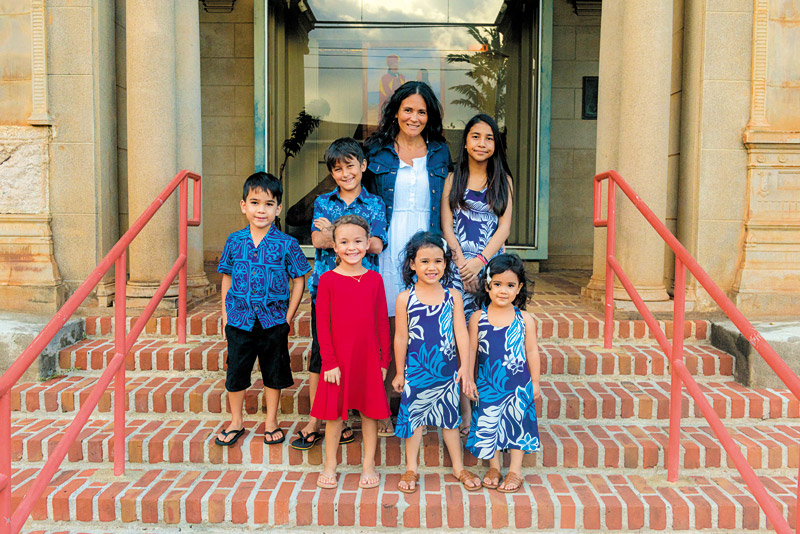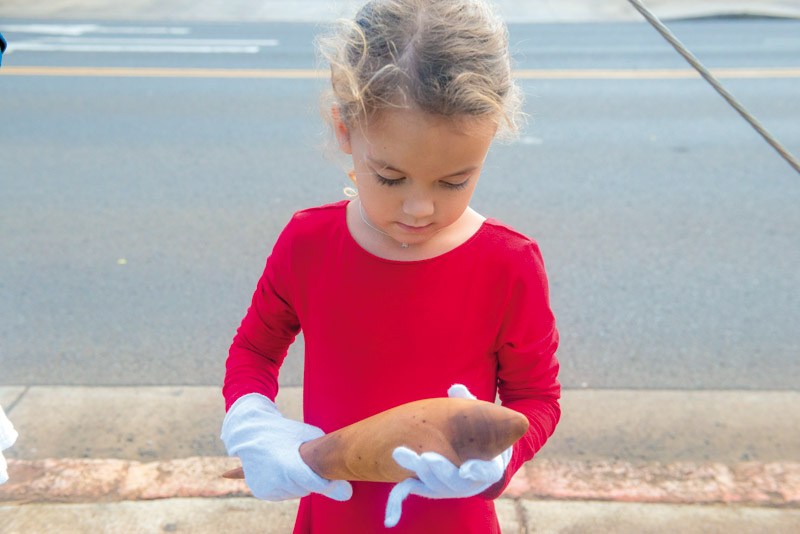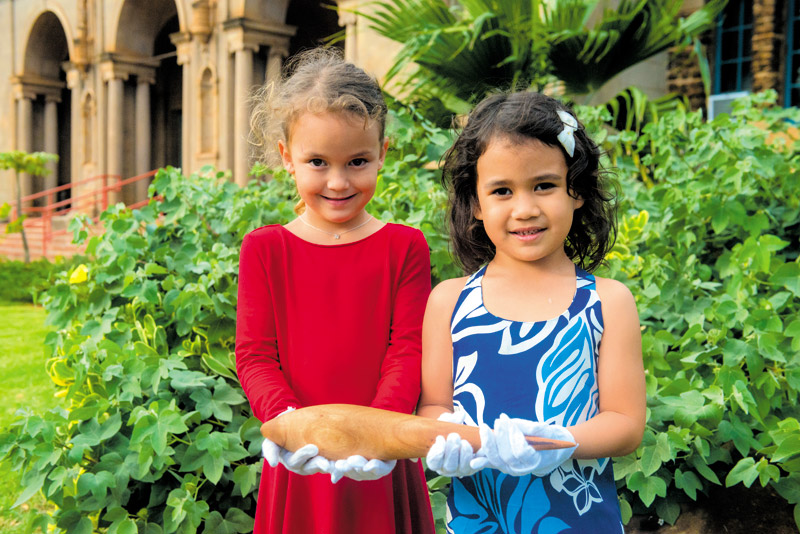Rapozos To The Rescue

The Rapozo family is responsible for the donation of Hawaiian artifacts to museums across the state. Pictured are some of the youngest members (back, from left) Lian Togioka, Talon Gage Ornellas, Kanani Ornellas, Ailee Togioka, (front) Naviah Ornellas, and Maila and Brynn Togioka.
Members of the Rapozo ancestral tree have been instrumental in returning ancient Hawaiian artifacts to their rightful place in Hawai‘i, and, in turn, the cultural items have brought their family together.
Three Hawaiian artifacts recently made their way back home to the Islands, thanks to the Rapozo ‘ohana. An ipu wai (water gourd) now permanently resides at Kaua‘i Museum; a moa pahe‘e (sliding dart used for makahiki games) was acquired by Lyman Museum in Hilo; and a Hawaiian bowl shaped like a goblet is in safekeeping at Bailey House Museum in Wailuku.
“The gift to the museums was to evidence the extended family’s thanks for being part of Hawai‘i life, and to show that safeguarding Hawai‘i’s cultural life is all our kuleana,” says Wayne James Rapozo, who purchased the items from the Rainer Werner Bock collection during a spring 2017 auction in Paris. “My view is that without Hawai‘i’s many extended families, the cultural fabric of Hawai‘i would be at risk of fraying.”
Rapozo grew up in Pākalā on the westside of the island and now lives in London, where he is an international lawyer and management consultant. His great-great granduncle, Manuel Rapozo, and great-great-grandfather, Francisco Rapozo, arrived in Hawai‘i on the SS Hansa in the 1800s. They eventually made their way to Kaua‘i and are the basis for a large branch of the extended Rapozo family that, according to Wayne James, includes virtually every ethnic group comprising Hawai‘i’s rich cultural legacy.

Naviah Ornellas examines a replica of a moa pahe‘e that’s similar to the original artifact her family donated to Bailey House Museum on Maui.
Protecting that heritage and helping his ‘ohana — the same family involved in the Mark Zuckerberg litigation over their kuleana land — preserve the culture of Hawai‘i has been of utmost importance to Wayne James for as long as he can remember. In fact, since moving to London in the 1990s, he has made it a goal to get to every major auction to find historical Hawaiian items.
Prior to attending last year’s auction, where he acquired the three artifacts, he had made a list of 10 items that were of cultural significance that would be available. He was able to purchase six — three of which were donated immediately and the other three are currently being reviewed by cultural experts. He also made a point to connect with various family members, including those on Kaua‘i, who had nothing but clear support for his mission.
“I’m grateful to my cousin who was able to grab a number of significant pieces,” says Kanani Ornellas. She’s the mother of Talon Gage, 8, and Naviah, 5, who are descendants of Manuel Rapozo. “These are very, very special and sacred pieces,” she adds.
What’s more is that, not only have the artifacts allowed people to gain knowledge about the culture, but they also happened to bring members of the family together who had never met before. Ornellas and her keiki were introduced to Leola Togioka and her five children – Ailee, 10, Lian, 6, Maila, 5, Brynn, 3, and Hana, 1 — for the first time during a Kaua‘i Midweek interview at Kaua‘i Museum.

Chucky Boy Chock, executive director of Kaua‘i Museum, with the ipu wai from Ni‘ihau donated by the Rapozo family that is currently on display at the Līhu‘e repository.
“We have to save all of these artifacts for our children to enjoy when they get older,” says Togioka, who is a descendant of Francisco Rapozo. “If we don’t preserve the culture, it will no longer be there for our children.”
Chucky Boy Chock, executive director of Kaua‘i Museum, says it was an honor to receive the ipu wai from the family.
“To know that Wayne (James) was trying hard to find the right artifact for Kaua‘i Museum shows his compassion and aloha to give back to a place he once lived,” he says.
The ipu wai, which is currently on display at the Līhu‘e repository, is suspected to have originated from Ni‘ihau and dates back to the 1700 or 1800s. The artifact remains in pristine condition with its still-intact shell that served as a cap to prevent water from spilling out.
What makes this gourd even more unique is that it is a small size and contains no designs. One theory for this is that the item was a device for the working man to quench his thirst, rather than used for formal ceremony.
“Easy to carry on a trip to the beach or the mountains or working in the yam fields without being a burden,” says Wayne James.
Chock says Kaua‘i Museum docents use the analogy of today’s Hydroflask to explain the use and function of the ipu wai to visitors. Guests of Kaua‘i Museum can also view a 1960s replica of the 1800s makahiki dart that Wayne James donated to the Lyman Museum.
While there isn’t a replica of the Hawaiian bowl shaped like a goblet at the local gallery, guests of Bailey House Museum on Maui can see the item, which is believed to have originated from Lahaina and dates back to the 1800s. What sets the bowl apart is that it is indicative of the changing times in Hawai‘i, when missionaries started to arrive, and was likely used as a chalice for wine during early Christian services.
“It is a fascinating piece because it shows Hawaiians adapting to new influences but with the materials they had and with great craftsmanship on display,” says Wayne James.
The Waimea High School grad wants to continue bringing as many cultural artifacts home as possible and plans to attend every Hawaiian and Pacific auction in Europe.
“The intent and hope is that our keiki have a point of pride and sense of dignity, and our kūpuna know they will not be forgotten by having something symbolically big in their name at Hawai‘i’s museums,” he adds.




